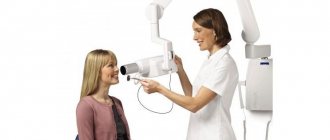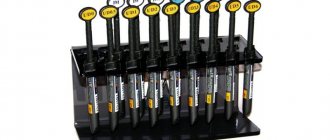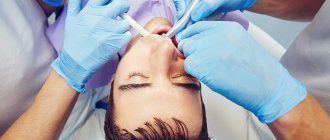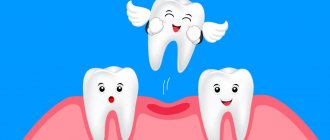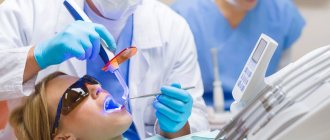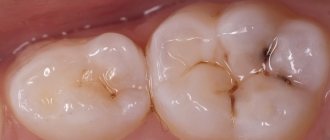- home
- For patients
- Articles
- Dental examination by a dentist
Anyone knows that taking care of your teeth is important. That is why, before treating them, it is necessary to first carry out a diagnosis to identify the cause of the pain. At the One to One dental clinic, the study is carried out in three ways:
- percussion of the tooth crown;
- palpation;
- probing;
These studies are performed as a set of procedures and are similar to each other. The similarity of these methods is that only one tooth is examined at a time, the examination is visual, and this is done by one doctor.
Instrumental visual examination of the oral cavity
When examining the oral cavity, the dentist examines the condition of the cheeks, gums, as well as healthy and diseased teeth. This makes it possible to identify the cause of the pain. This type of research has two stages:
- Visual inspection;
- Probing.
A visual examination of the teeth determines the condition of the tooth enamel. Probing checks the strength of the enamel and the condition of the tooth surface.
Instrumental and visual diagnostics
This type of study is carried out at the One to One clinic in order to be able to identify the extent of tooth decay by caries, and to exclude such types of diseases as hypoplasia and fluorosis, which have nothing to do with caries.
During an examination, any doctor will definitely pay attention to the color of the enamel, or rather to the shades; if it differs from the natural “living” shine, then this indicates that a more thorough study is necessary to identify the diagnosis:
- Gray enamel indicates that pulp removal is necessary.
- Treatment using depophoresis is used for yellow enamel.
- The resorcinol-formaldehyde treatment method is used only for pink enamel.
The purpose of probing is to determine the presence of secondary caries in the teeth on which the filling was placed; it also reveals disease in the grooves on the chewing surfaces, called fissures.
Root tooth fissures
Dental instruments for surgery
Taking into account the specifics of this area of medicine, instruments of this type are intended for exfoliation of the gums immediately before tooth extraction, of course, the forceps themselves for removing teeth, forceps for removing the roots of teeth (elevators), as well as syringes, bayonet-shaped, straight, and angled.
Clamps, scalpels, needles and needle holders and other types of instruments for surgical dentistry are so diverse that if you want to buy one or another instrument, you need to clearly understand for what purpose you are purchasing it, and even better, consult with specialists on this issue.
Professional consultants will definitely tell you not only about all the advantages, but also the disadvantages of the group of instruments you are interested in, indicate the correct selection criteria, and tell you what you need to pay attention to when purchasing a certain type of dental instruments.
Probing
To carry out probing and visual examination, the dentist uses an angled probe that has a notch at the end; it must be blunt.
To determine the degree of roughness, the doctor runs an instrument over the surface of the enamel:
A healthy tooth has a smooth surface, but if the tooth is affected by caries, the enamel surface will be rough. The doctor is obliged to check the condition of the periodontal pocket; to do this, he inserts a probe into the gingival groove on four sides of the tooth; if the probe sinks to a depth of 1 mm, then the pocket is healthy. If the immersion is much deeper, this may indicate that the periodontium is atrophied, and this may be caused by pathology.
Atrophied periodontium caused by root caries
Symptoms of the carious process are the following: the size of the gap between the tooth and the filling is increased, the dentitis under the chewing surface is too soft.
During an initial visual examination, it is very difficult to detect tartar deposits on the neck of the tooth, which is located in the periodontal pocket, but this can be detected through probing. The occurrence of periodontitis and gingivitis is provoked by subgingival calculus. The formation of superficial caries can only be recognized by visual inspection.
Dental instruments for dental treatment
In their practice, dentists use various dental instruments to examine the patient’s oral cavity and treat damaged teeth. Each instrument has its own purpose and is used for the doctor’s most painless manipulations with damaged teeth and gums.
Inspection Instruments
The dentist, after listening to the complaints of the patient who contacted him, must carry out an examination, which consists of a thorough examination of the oral cavity and teeth. A professional dental examination is carried out using diagnostic tools:
— diagnostic mirror – is a round mirror on a long handle and is used to examine areas in the patient’s mouth that are difficult to access and invisible during visual inspection; - probe - looks like a hook with a long handle and is used to determine defects and dental caries, the depth of the carious cavity, its density and sensitivity, as well as the presence of tartar; - tweezers - used by the doctor to determine how loose the tooth is, as well as to place or remove a cotton swab.
Tools for treatment
Treatment of a carious cavity discovered during examination by a dentist consists of several complex stages:
- opening of the cavity; — cleansing and removal of damaged tooth tissues; — filling the cleaned cavity.
Special dental instruments are also used to treat caries:
- dental excavator - is an elongated holder with curved thin ends on both sides, used to remove temporary fillings, food debris and soft damaged tooth tissues; the excavator also removes plaque and deposits on the teeth; - smoothers and spatulas - they are a long holder with spatulas on both sides; they are used to mix filling materials and place them in the open cavity of the tooth; - bur - used to open the cavity and clean it from tissues affected by caries; there are several types of burs for the convenience of cleaning cavities of different shapes, sizes and depths; - disc - used after closing the cavity with a filling to smooth its surface and sharp edges that could remain after treatment with boron; - polisher - the purpose of polishers is the same as that of discs, but they have a different shape. Using the listed tools, the dentist will conduct a preventive and diagnostic examination and save the patient from caries and other dental defects.
Palpation examination
Using this research method, inflammatory processes are identified, as well as the nature and stage of development of periodontal destruction. To more accurately understand the condition of the tooth, they begin to move it in different directions using tweezers, this makes it possible to understand how it moves in the alveolus:
- In three directions
- In five together with vertical
- In one
- In two.
If a tooth gives in very easily with a little force, this means that there are deviations from the norm, which may be accompanied by tissue swelling and an inflammatory process. These symptoms may indicate the presence of traumatic tooth lesions, such as periodontal disease, periodontitis and periodontitis. It is by palpating the cheeks and gums that the “One to One” doctor receives information about the presence of purulent or bloody discharge, pain, compaction and swelling. A big plus that can be given to the method is that it allows you to instantly obtain the research result upon examination. The only negative that unfortunately exists is the inability to make a definitive diagnosis.
When should you undergo a general examination by a dentist?
Experienced dentists and orthodontists strongly recommend visiting a dental clinic for a preventive examination at least once every 6 months. This should be done even if there are no complaints. If you have any unpleasant sensations, you should not delay your visit to a medical facility for even a minute.
There are several main causes for concern: increased sensitivity of the enamel, pain in the gums under the denture, swelling, redness and any other visible tissue changes. Also, one of the symptoms of developing pathology is a strong smell from the mouth, which does not disappear even after brushing.
Abundant accumulation of plaque and tartar, changes in the shade and transparency of the enamel, bleeding - all this is a good reason to visit your doctor. Also, consultation and examination are required before orthodontic treatment.
previous post
Why are my teeth numb?
next entry
Percussion (tapping)
Percussion with tweezers or a probe handle along the crown of the tooth allows you to determine the location of the area affected by inflammation. Any examination begins with healthy teeth; for this purpose, the edges responsible for cutting and chewing reflexes are tapped on the top and sides of the crown.
The process of tapping teeth (percussion)
A good idea of where the source of inflammation is located is given by the relationship between the nature of the pain and the direction of the blow: periodontitis is detected with a horizontal blow, damage to the root nerve can be determined with a vertical blow. Thanks to this technique, the doctor has the opportunity to identify the place where there is pain and prescribe the necessary treatment.
The influence of the price of instruments on the price of dental services
Let's be honest, many of the patients of dental clinics are frightened at the sight of new and modern dental equipment, believing that dental treatment in such an institution will cost much more.
How does the average private dentistry patient think? The management may try to return the huge amount of money invested in a private dental clinic as soon as possible, so the prices here will be unreasonably high! But in practice, given competition, regulations and rules, many dentists make concessions, trying to find the so-called “golden mean”.
Speaking of Yulistom, management is constantly searching and monitoring promotions for dental equipment and materials.
They are purchased directly from manufacturers, bypassing stores with the appropriate specialization. It is thanks to this that patients of dental clinics near the Zvezdnaya and Pionerskaya metro stations in St. Petersburg are offered affordable prices for healthy teeth! And don’t let modern dental equipment scare you, it in no way affects the fixed prices of dental services (price list at the link). Moscow metro station Zvezdnaya, Danube Avenue, 23
Orthopedist instruments
Among the instruments used in prosthetics, the following main groups should be distinguished:
- Burs and discs for tooth preparation;
- Impression trays for the lower and upper jaws (full, partial, for partial impressions of both jaws, etc.;
- Tools for sawing, cutting and removing crowns, as well as for pushing apart the edges of sawn crowns;
- Micrometer for measuring crown thickness,
- Various spatulas for mixing impression materials, cements for fixation, etc.;
- Tools for determining correct facial proportions, central closure of teeth, etc.
List of additional tools
In the process of work in surgery, not only modern equipment is used, but also hand instruments:
Inflammation after wisdom tooth removal
- Bit. The design is used in rare cases, due to its large size and awkward shape. The instrument is used as an additional lever, which is placed between the alveolar part of the tooth and its roots. In some cases, a chisel can simplify the procedure of tooth extraction.
- Hammer. It is used only for surgical indications, when, for example, it is necessary to hollow out the root part of the elements. The instrument is one of the most traumatic, so it is used only in rare cases.
- Drill. Used only in the extraction process of multi-root units.
- Luxator. The design has a thin shape, allowing the doctor to freely penetrate the periodontal area. In modern clinics, surgeons are increasingly replacing standard forceps with luxators, as they provide minimal risk of injury to the jaw bones.
- James Elevator. Used for complex operations, for example, when removing wisdom teeth from the oral cavity. There are several types of tools: right- and left-handed, straight, curved.
- Cryen's Elevator. It, like the previous surgical instrument, is designed to perform complex operations, but differs in shape. The Cryen elevator has a triangular shape with a sharp apex. Dentists call the instrument a “goat leg” differently. Using a sharp tip, the patient cleans the carious cavity from dead particles of dentin and enamel, as well as pathogenic bacteria.
The elevator is used by the dentist to remove tartar.
The specialist decides which tool to use in a particular case. He makes his choice depending on the complexity of the situation and the structure of the affected unit.
Features of using various tools for tooth extraction
If it is not possible to save the affected unit, then the patient is prescribed surgery to remove it. All dental instruments must be processed and sterilized to prevent the development of complications after extraction.
Forceps
The doctor chooses the type of instrument that best suits the anatomical features of the tooth being removed. He moves the soft gum tissue so that the axis of the tooth coincides with the axis of the forceps. After this, the instrument is advanced to the neck of the element to ensure its better fixation. The doctor places the forceps in such a position that the axes of the crown of the element and the instrument coincide.
The doctor’s further actions depend on how many roots the tooth being removed has. Single-root units are extracted by rotational movements, multi-rooted ones by pendulum movements. Thanks to this, the nerve fibers of the tooth are destroyed and it is quickly removed from the thickness of the gum. After the destruction of periodontal tissues, the surgeon eliminates the problematic unit using rotational actions. Then the doctor sterilizes the hole and gives instructions to the patient regarding behavior during the rehabilitation period.
Elevator
To remove teeth, the elevator is used as a lever. Depending on the type of element, the surgeon can use a straight, angled or bayonet-shaped instrument. The first is necessary for extracting units located on the upper jaw, the second - for working with the lower teeth. The bayonet elevator is used to extract wisdom teeth or in situations where the patient is unable to open his mouth wide.
Doctors prefer to destroy the crown part of the teeth using a drill or chisel. The elevator is used to remove the root part of the affected tooth and to remove dental plaque.
Luxators
The use of the tool is indicated in difficult cases. The list of such situations includes:
- Abnormal position of the tooth roots relative to the jaw bones.
- Strong periodontal ligament of the tooth.
- Impossibility of tooth extraction due to insufficient filling of the socket with blood and air.
- Tooth extraction in children.
Luxators are designed to prevent severe damage to the soft tissues of the tooth. For each element and its root, a tool of the appropriate size is selected. The working part of the luxator is inserted as much as possible under the gum, as a result of which the vacuum that interferes with the removal of the unit is eliminated.
To remove different types of teeth, doctors use certain tools that best provide access to the roots of the element being removed. During the procedure, it is important for the surgeon not only to choose the right instruments, but also to follow all antiseptic rules in order to eliminate the risk of complications in the future.

